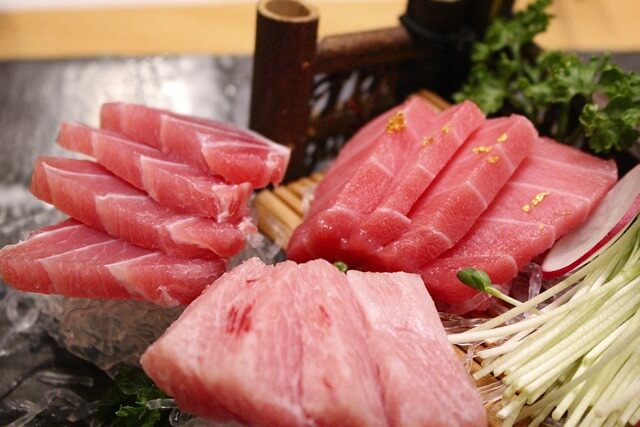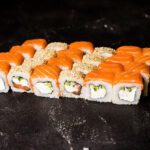There are many different types of sushi that have become very popular, not only in Japan but also in Western countries. Many people enjoy tuna sushi since tuna is a very popular ingredient used in many common western dishes. Tuna sushi can be delicious, so it makes sense that you would want to learn how to make it.
To make tuna sushi, you need to prepare the ingredients (tuna, sticky rice, scallions, and optional ingredients), prepare the sushi mat, arrange the ingredients on the mat (rice, then fillings) and roll the sushi. Once you have extracted the mat and shaped the roll, add garnishes.
If you’re interested in learning how to make tuna sushi, read on. You can learn a little bit about the process and the different ingredients that make up this delicacy.
Types of Tuna Used in Sushi
Tuna sushi is one of the most popular kinds of sushi. Tuna is fairly accessible as well since you can find it all around the world. It has been a pretty important staple within Japanese cuisine for quite a while. This fish can grow up to two meters long and weigh anywhere between two kilograms and over 100 kilograms.
Many different species of tuna can be a part of tuna sushi. Some popular options that are used in Japanese restaurants are the following:
- Bluefin tuna. This type of tuna is typically an inhabitant of the Atlantic Ocean. It is the largest tuna species found on this planet and is considered a luxury item in Japanese cuisine.
- Bigeye tuna. This species of tuna has notably big eyes, hence its name. It is found in most of the world’s oceans, and the flesh on this fish is typically leaner than the flesh that you would find on bluefin tuna.
- Yellowfin tuna. This type of tuna is named for its characteristic yellowfins. It is found in many water bodies worldwide and is one of the most common species of tuna that is eaten in Japan, whether within sushi or in some other type of meal.
- Southern bluefin tuna. This tuna is very similar to the regular bluefin tuna. It is found in the Pacific Ocean and other waters nearby. It is an endangered species, and there are quite a few restrictions on catching it.
- Albacore tuna. This is one of the most popular tuna species used in sushi making. It is found in most of the world’s oceans and often sold in cans, marketed with the name “white tuna.” However, it is not truly white tuna; real white tuna is a different fish that humans cannot digest and is banned from marketing in Japan (Escolar).
There are different types of meat that come from tuna fish. These are referred to as follows in Japanese cuisine:
- Akami. This is the part of the meat that is fairly dark. It is known to have high amounts of protein and a very low amount of fat.
- Chu-Toro. This is the portion of tuna meat that has moderate amounts of both protein and fat. It has an equal proportion of both light and dark spots to reflect this.
- O-Toro. This is part of the tuna that has the highest proportion of fat. It has a characteristic marbled appearance.
When you prepare sushi, the process is very similar to other types of sushi. Usually, it is eaten with vegetables and fermented rice as part of a sushi roll that you can prepare.
How to Make Tuna Sushi Rolls
Tuna sushi rolls are a type of hosomaki, a simple thin sushi roll with few ingredients. Alternatively, you can prepare a tuna sushi roll as a type of uramaki with all the same ingredients that have the rice on the outside instead of the seaweed paper (nori).
At the end of the day, what you put in your tuna sushi roll is really up to you. However, these sushi rolls are typically going to include sushi-grade tuna and sushi rice, scallions, and nori.
The following is a list of ingredients for one popular recipe of the spicy tuna roll:
- 1 ½ cups of cooked sushi rice
- 4 ounces of sushi-grade tuna
- ½ teaspoon of roasted sesame oil
- 2 green onions, sliced finely
- 1 sheet of seaweed paper (nori)
- 2 tablespoons of white sesame seeds (toasted)
- 4 teaspoons of Sriracha sauce (optional)
- 1 tablespoon of Japanese mayonnaise (optional)
- Soy sauce (optional)
- Wasabi (optional)
If you want to include spicy mayonnaise in your recipe, you will mix the tablespoon of Japanese mayonnaise with one teaspoon of Sriracha sauce. Since this is a very simple step, you can do this before arranging ingredients in the actual sushi roll.
You can prepare and serve these tuna rolls in a variety of ways. The optional ingredients give you a few different flavor combinations. You can either omit all of the optional ingredients, serve them playing, serve them with Sriracha sauce and Japanese mayonnaise, or serve them with soy sauce and wasabi.
You can even include all of the optional ingredients and have huge bursts of flavor, although this might be too much for some people.
Additionally, you can make Tezu, a rice vinegar-water solution; you complete it by mixing 1 tablespoon of rice vinegar with 1/4 cup of water. Having the solution around will make things easier while working with the sticky rice since if you apply it to your hands, it’ll prevent the rice grains from sticking to your skin.
The Ingredients in Making Tuna Sushi
If you want to make any sushi by hand, there are certain steps that you can follow. Before you begin, there are a few things that you are going to need:
- Sticky rice (sushi rice)
- Seaweed paper (nori)
- Bamboo sushi mat
- Plastic wrap
- Wooden spoon or other flattening tools
- Sharp knife
- The sushi fillings of your choice (tuna, in this case)
Before you start to roll the sushi, you will need to cook the rice yourself. All ingredients need to be prepared before you start using the sushi mat to do the rolling.
Prepare the Ingredients
Before you start constructing your tuna sushi roll, it’s important to make sure that you have all the ingredients and that they are prepared. Slice the fillings, including the tuna fish, into little strips. Having them in this shape will make it easier to put into the sushi roll. You’re also going to need to cook and prepare the sticky rice.
Alternatively, you can either mince the tuna or cut it into ¼-inch cubes. In a medium-sized bowl, mix all the tuna pieces well with the roasted sesame oil and some of the scallions (you’re going to save some of the scallions to use as garnishes at the end). If you’re going to be using Sriracha sauce, add three teaspoons of it to this mixture.
You will need to use short or medium-grain white rice for your sushi. This type of rice is going to be better sticky rice than other types. Before cooking it, make sure to rinse it thoroughly until you see that the water around it is not cloudy.
You want to make sure that the rice does not have any unwanted powder, such as powdered glucose or talc, on the surface. Without these unwanted ingredients, the flavor of your final result will be better.
Now, put your washed rice into a bowl with water. The amount of water that you should include should be three times the volume of the rice. Then, stir the rice grains with your hands since this will take away any powder that might still be left on the rice.
Once you have done this, pour the rice and water through a mesh strainer. Repeat that step again and again until you see that the water is not cloudy anymore. Now, it’s time to cook the rice.
After you have cooked the rice, allow it to cool to room temperature. Once it is at room temperature, it will be easier for you to work with while making the sushi.
When you see that the temperature has lowered, sprinkle a little bit of rice vinegar on the rice. This will give it a little bit of additional flavor, which will improve your sushi flavor. Be sure that the rice vinegar is evenly distributed throughout the rice.
Wrap the Bamboo Sushi Mat
Before you start rolling your sushi, you are going to want to prepare the sushi mat. Cover it up with a plastic wrap. Alternatively, you can put it into a Ziploc bag that is larger than the mat. The reason for the plastic is that if it’s not there, the rice is very likely to get stuck to the sushi mat. This might not seem like a big deal, but this cannot be easy to clean up.
Arrange the Ingredients
It is now time to put all of the ingredients together to make your sushi roll. Start by placing one half of a sheet of seaweed wrap on your bamboo mat. Ensure that the shiny side is facing down and that the nori edges are lined up with the sushi mat’s edges.
After you have done this, wet your fingers in the Tezu solution that you mixed earlier to prevent the rice from sticking to your fingers. Then, it’s time to put a layer of sticky rice on top of the nori. The layer should be about 1/4 of an inch thick.
Make sure that you leave about half an inch of seaweed paper bare on each of the edges, as this will leave room for the rice and fillings to expand when you squeeze it into shape at the end without spilling out.
Make the layer of rice as even as possible on top of the nori. If you need to do so, you can use a wooden spoon to make the layer flat and even. Once you complete the rice layer even, sprinkle the sesame seeds as evenly as possible on top of the layer.
Since tuna sushi is often made with rice on the outside of the nori, at this point, you would flip the nori sheet with rice over so that the rice is facing down and in direct contact with the plastic wrap. However, if you want the seaweed paper on the outside, you would leave it and proceed with the steps.
You can now start arranging the sushi fillings on top of the rice (or the nori, if you have chosen not to make this sushi roll an uramaki). Put the tuna pieces down so that they are in a lengthwise orientation.
You should make the line of fillings as neat as possible and arrange them to start about one inch from the bottom of the rice layer to your position. Remember to use about half of them since you will be using the other half with the other nori sheet.
Begin the Rolling Process
Please take a few drops of water before you start rolling and slightly wet the seaweed paper’s edges. Only do this to the part of the nori that you have not covered with rice. This will make it easier for you to seal up the sushi roll when you are done rolling.
Now, it’s time to start rolling. Start by folding one end of the bamboo mat, with all of the ingredients on top, towards the other side. While you are rolling, keep the roll as tight as possible. Use your fingers to move all of the fillings towards the center to keep everything organized.
When you are done with the mat, all of the food ingredients inside should be in the shape of a tube. The roll should be entirely covered with a bamboo mat, which you can use to squeeze all of the interior’s sushi ingredients. Make sure that everything is compact and firm, and you can shape it just as you wish.
Extract the Mat
Once you have made the entire sushi roll, it’s time to remove the mat. You should extract it very carefully, or else all of the rice and fillings could end up falling apart and making a big mess.
Cut the Sushi Roll
After you have removed the mat and have your sushi roll intact and in the desired shape, use a very sharp knife to cut it. It’s important that the knife is sharp since if you use a dull knife, you may end up just shifting the ingredients around and making a mess while not being successful at cutting it.
Cut your sushi roll into two halves, and then cut the halves into bite-size pieces. You can now put a little bit of spicy mayo on the top of each piece of sushi. Garnish the bite-sized pieces with the rest of the scallions. At this point, you can repeat the whole process with the other half sheet of nori and the rest of the ingredients, and then you’ll have two sushi rolls.
Serve your sushi pieces with the dipping sauces of your choice, and enjoy. Ensure that you cover them with a clean, damp cloth not to dry out when they are not in use.
Eat the Sushi Roll
Of course, this isn’t part of the creation process, but it is one of the most important and perhaps one of the most enjoyable steps! It’s time to eat what you have just made. There are a few etiquette rules that you might be interested in learning about eating sushi:
- Don’t worry about it if you aren’t able to eat with chopsticks. It’s acceptable to eat sushi with or without chopsticks, although this isn’t the case with sashimi (plain raw fish).
- If you are going to be eating with chopsticks, don’t rub them together. This is considered to be rude.
- Generally speaking, you can follow the standard rules of etiquette that you usually do. You don’t need to panic and worry that you aren’t eating your sushi correctly or appropriately, as this will take away from the event’s enjoyment.
Sushi is good with wasabi and soy sauce, although if you are using these ingredients, you don’t want to use too much. Wasabi, in particular, has a very strong flavor that not everyone can handle. You might also want to be a little bit leery of using these ingredients if you have used Sriracha sauce and spicy mayo as well.
Eating gari, or ginger, is also thought to be a good cleanser; you can eat a few pieces every few bites and then do the tuna roll.
Conclusion
If you’re interested in learning how to make tuna sushi, you should try it. It can be quite a challenge, and you might fail on your first attempt, but this doesn’t mean that it’s not worth a try. Once you get the hang of it, you can have a lot of fun, both making and eating it.
Some people might not think that raw fish can make a great meal, but the truth is that it can. It can also be a great snack. Learning to make sushi can give you great meals and a unique form of entertainment.
Sources
- air kitchen: A Guide To Tuna Sushi
- Wikipedia: Escolar
- Fish on Friday: Know your sushi
- The Spruce Eats: Tekka Maki Tuna Sushi Roll
- Kobe Steakhouse: Uramaki
- Wikipedia: Nori
- Just One Cookbook: Spicy Tuna Rolls スパイシーツナロール寿司
- Wikipedia: Sriracha
- Wikipedia: Wasabi
- Just One Cookbook: Homemade Spicy Mayo スパイシーマヨ
- Cook’s Info: Tezu
- eHow: How to Use a Bamboo Sushi Roll Mat
- Wikipedia: Glucose
- Wikipedia: Talc
- Thrillist: How to Roll Sushi Like a Pro
- Wikipedia: Sashimi
- Wikipedia: Gari (ginger)



